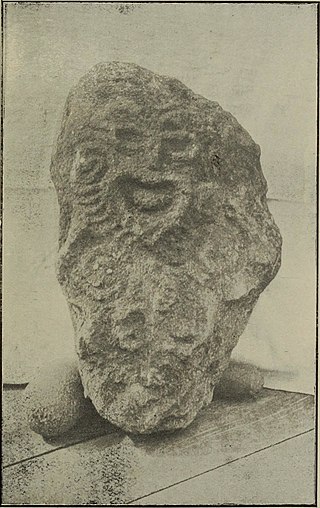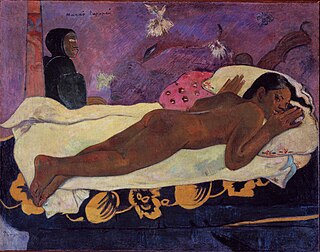Related Research Articles

Polynesian mythology encompasses the oral traditions of the people of Polynesia together with those of the scattered cultures known as the Polynesian outliers. Polynesians speak languages that descend from a language reconstructed as Proto-Polynesian – probably spoken in the Tonga and Samoa area around 1000 BC.

In Māori mythology, Rongo or Rongo-mā-Tāne is a major god (atua) of cultivated plants, especially kumara, a vital crop. Other crops cultivated by Māori in traditional times included taro, yams (uwhi), cordyline (tī), and gourds (hue). Because of their tropical origin, most of these crops were difficult to grow except in the far north of the North Island, hence the importance of Rongo in New Zealand.
In Hawaiian religion, Hiʻiaka is a daughter of Haumea and Kāne.
Haumea is the goddess of fertility and childbirth in Hawaiian mythology. She is the mother of many important deities, such as Pele, Kāne Milohai, Kāmohoaliʻi, Nāmaka, Kapo, and Hiʻiaka. Haumea is one of the most important Hawaiian gods, and her worship is among the oldest on the Hawaiian islands. She was finally killed by Kaulu.

In Māori mythology the primal couple Rangi and Papa appear in a creation myth explaining the origin of the world and the Māori people. In some South Island dialects, Rangi is called Raki or Rakinui.
Atua are the gods and spirits of the Polynesian peoples such as the Māori or the Hawaiians ; the Polynesian word literally means "power" or "strength" and so the concept is similar to that of mana. Today, it is also used for the monotheistic conception of God. Especially powerful atua include:
In the traditions of ancient Hawaiʻi, Kanaloa is a god symbolized by the squid or by the octopus, and is typically associated with Kāne. It is also an alternative name for the island of Kahoʻolawe.

In Hawaiian mythology, Laka is the name of two different popular heroes from Polynesian mythology..

In Hawaiian religion, Pele is the goddess of volcanoes and fire and the creator of the Hawaiian Islands. Often referred to as "Madame Pele" or "Tūtū Pele" as a sign of respect, she is a well-known deity within Hawaiian mythology and is notable for her contemporary presence and cultural influence as an enduring figure from ancient Hawaii. Epithets of the goddess include Pele-honua-mea and Ka wahine ʻai honua.

Ancient Hawaiʻi is the period of Hawaiian history preceding the unification in 1810 of the Kingdom of Hawaiʻi by Kamehameha the Great. Traditionally, researchers estimated the first settlement of the Hawaiian islands as having occurred sporadically between 400 and 1100 CE by Polynesian long-distance navigators from the Samoan, Marquesas, and Tahiti islands within what is now French Polynesia. In 2010, a study was published based on radiocarbon dating of more reliable samples which suggests that the islands were settled much later, within a short timeframe, in about 1219 to 1266.
Hawaii is a novel by James A. Michener published in 1959, the year that Hawaii became the 50th U.S. state. It has been translated into 32 languages.

The culture of the Native Hawaiians encompasses the social behavior, institutions, and norms practiced by the original residents of the Hawaiian islands, including their knowledge, beliefs, arts, laws, customs, capabilities, and habits. Humans are estimated to have first inhabited the archipelago between 124 and 1120 AD when it was settled by Polynesians who voyaged to and settled there. Polynesia is made of multiple island groups which extend from Hawaii to New Zealand across the Pacific Ocean. These voyagers developed Hawaiian cuisine, Hawaiian art, and the Native Hawaiian religion.

In Hawaiian religion, Māui is a culture hero and ancient chief who appears in several different genealogies. In the Kumulipo, he is the son of ʻAkalana and his wife Hina-a-ke-ahi (Hina). This couple has four sons, Māui-mua, Māui-waena, Māui-kiʻikiʻi, and Māui-a-kalana. Māui-a-kalana's wife is named Hinakealohaila, and his son is named Nanamaoa. Māui is one of the Kupua. His name is the same as that of the Hawaiian island Maui, although native tradition holds that it is not named for him directly, but instead named after the son of Hawaii's discoverer.

Hawaiian religion refers to the indigenous religious beliefs and practices of native Hawaiians, also known as the kapu system. Hawaiian religion is based largely on the tapu religion common in Polynesia and likely originated among the Tahitians and other Pacific islanders who landed in Hawaiʻi between 500 and 1300 AD. It is polytheistic and animistic, with a belief in many deities and spirits, including the belief that spirits are found in non-human beings and objects such as other animals, the waves, and the sky. It was only during the reign of Kamehameha I that a ruler from Hawaii island attempted to impose a singular "Hawaiian" religion on all the Hawaiian islands that was not Christianity.

ʻOro is a god in Tahiti and Society Islands mythology. The veneration of ʻOro, although practiced in varying intensity among the islands, was a major religion of the Society Islands in the 17th and 18th centuries, especially Tahiti, Tahaa, Moorea, and Raiatea. On Tahiti, ʻOro was the main deity and the god of war. The secret society of Arioi was closely linked because of its rites. On the Marquesas Islands, ʻOro bore the name Mahui.

Guayota, in Guanche mythology of Tenerife, was the principal malignant deity and Achamán's adversary.

There was widespread belief in ghosts in Polynesian culture, some of which persists today. After death, a person's ghost would normally travel to the sky world or the underworld, but some could stay on earth. In many Polynesian legends, ghosts were often involved in the affairs of the living. Ghosts might also cause sickness or even invade the body of ordinary people, to be driven out through strong medicines.

The mythology of Oceania and the Gods of the Pacific region are both complex and diverse. They have been developed over many centuries on each of the islands and atolls that make up Oceania. While some gods are shared between many groups of islands while others are specific to one set of islands or even to a single island. Their exact roles are often overlapping as one god can appear in different places under different names. A god can also appear in many different forms.
According to ancient Hawaiian myth, Milu is the god of the dead and ruler of Lua-o-Milu. He is now thought to share analogs with Hades. Under his command, are a host of beings known as spirit catchers who would trap wandering ghosts and bring them to his afterlife domain. He fought alongside Ulupoka against Pele. In one legend, a chief harrowed of the loss of his wife, has his prayers answered and receives guidance from a deity who shows him the way into Milu's kingdom. They journey far out and find a tree split in two. Next they slide down it into the Earth's lower regions. Here, the deity hid behind a rock and covered the chief with odd smelling oil then sent him out by himself. Once the chief found Milu's palace, he noticed a group of spirits who were so distracted in the game they were playing, he was able to join, and luckily, when they did realize he was near them, they mistook him for a stinking ghost. When the crowd was finished, they wanted to play another game, hence the chief proposed they should all pull their eyes out and paid his attention to those belonging to Milu. He later caught them in a coconut cup and blinded the god. Now he was able to escape to Wākea's heaven, where the Underworld's inhabitants could not set foot. Eventually a deal was made and Milu's eyes were returned, on the condition that the chief's wife's soul be brought back.
References
- ↑ Knappert, Jan (1992). Pacific Mythology: An Encyclopedia of Myth and Legend. Aquarian/Thorsons. ISBN 978-1-85538-133-9.
- ↑ Kilworth, Garry (2014-01-16). Garry Kilworth SF Gateway Omnibus. Orion. ISBN 978-1-4732-0196-5.
- ↑ St.-Johnston, Sir Reginald (1918). The Lau Islands (Fiji) and Their Fairy Tales and Folklore. Times book Company, Limited. ISBN 978-0-598-42576-8.
- ↑ Kilworth, Garry (2011-09-29). The Roof of Voyaging. Orion. ISBN 978-0-575-11439-5.